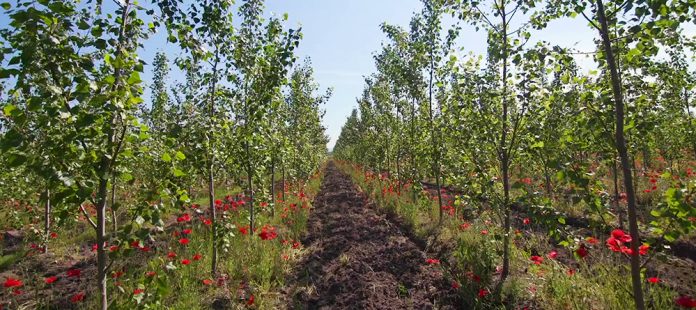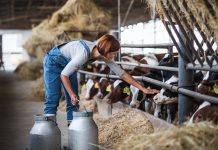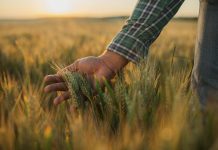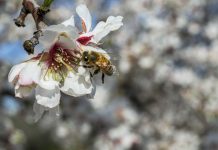Prof Dr Norbert Weber from TU Dresden argues that land availability for sustainable agricultural tree crops and a positive perception of this by the official administration both remain challenging hurdles
Dendromass4Europe (D4EU) is a project partnership for innovation towards sustainable European bio-economy with Short Rotation Coppices (SRC) and dendro-biomass utilisation. SRC is the legal term for agricultural crops with fast-growing trees. The three industrial partners IKEA Industry Slovakia, Pulp-Tec and Energochemica, the Slovak environmental NGO DAPHNE – Institute of Applied Ecology, and five research partners from Italy, Hungary, Austria Germany and Sweden are leading experts, for example, for SRC ecology and operations, for the sustainability of wood-based value chains or bio-based industrial operations. Recently, D4EU achieved a milestone. So far, 1,289 ha of FSC-certified1 SRCs have been established.
Sustainable agricultural tree crops
After two years, DAPHNE has evaluated biodiversity data that proves positive effects of the project’s SRCs on biodiversity in the fields that have been non-divers acreage before SRC establishment. In some situations, SRCs may even become a refuge for rare species. However, DAPHNE’s data also shows where planting SRCs can reduce the existing biodiversity due to shading by the tree canopies. That would be the case on valuable grassland. Therefore, the industrial partner concentrates its activities on marginal acreage. The growing dendromass stock forms the raw material basis for a complex sustainable bio-based value chain.
During the stage of market replication, four New Bio-Based Materials (NBBMs) will be produced. Industrial-scale SRC harvesting and production trials were successful, and preparing market replication is underway. As a highlight, the improvements in the agricultural ecosystem sustainability do not develop at the expense of the rural economy (cf. SRC text box). Contracted farmers or landowners are involved at the level of intensity that they prefer. Their operational activities and the new alternative income opportunity from marginal land create benefit.
The rural economy will be linked with the expanding European industrial bio-economy. Hence, D4EU can be recognised as a successful European example for bridging the gap between science-based knowledge for improved sustainability and the need for industrial and agricultural innovation. However, societal and economic conditions created obstacles that the D4EU consortium strives to overcome. D4EU is thoroughly considering all potential risks that may arise from SRC operations and unknown risks.
Biodiversity monitoring
The consortium has established risk control and management tools. Biodiversity monitoring is carried out. For instance, young SRCs form an open land biotope before canopy closure, which allows the desirable new pioneer flora to grow in the first years. Hence, a new livelihood is provided, for example, for bees and wild insects or small mammals. On the other hand, the succession does not only contain protected plants. It can entail the spread of weeds and potentially also of non-native or invasive species.
However, this risk is not specific to SRC, but generally to fallow or brownfield where natural succession is allowed. In SRC, the risk is relevant when the canopy is not fully shading out all weeds. The operating partner considers the risk with a mechanic countermeasure. To control ground vegetation, the SRC is being harrowed between the tree rows in the first years. Overall, the D4EU partners are optimistic that official authorities will agree with the successful handling of the risk and with the overall positive effect of the project’s SRCs.
This is particularly true concerning another minor risk. The cropped poplar trees belong to the group of hybrid, non-native poplars which can, only in the mature stage, mate with the native, partially endangered black poplar (Populus nigra). Genetic admixture can occasionally occur as non-native hybrid poplars have been planted as long as 100 years throughout Europe, for example, as ornamentals in cities, along rivers or canals, in shelterbelts, etc. As the D4EU poplars do not become older than four or six years within a SRC rotation cycle, the risk coming from D4EU is negligibly low for a successful rejuvenation of ‘impure’ P. nigra.
The risk would only materialise in the case of SRC trees that would not be harvested early enough or in case of SRCs that would not be re-converted after decades of use. However, both cannot be expected. Dendromass is a valuable feedstock, and acreage below SRCs legally remains farmland and does not become forestland. Normally, abandoned SRC stands are mulched and re-converted because classic acreage has a higher real estate value. Moreover, the SRC operational partner in D4EU and its land cooperation partners are legally bound to re-convert the SRC plantations after 20 years at the latest. This is assured by the certificate that is issued by the land district office in the respective project region.
Closing thoughts: Sustainability
Unfortunately, specific stakeholders, as the official administration, do often raise issues while only considering the potential risks of one specific field of responsibility. Often, the evidence for an overall positive effect of the SRCs for the variable aspects of sustainability is even neglected.
Irrespective of their willingness to become more sustainable and to fulfil all legal requirements, it seems that industrial partners, in particular, have to try hard to earn trust. One might speculate that a fundamental mistrust against economic innovation, like the bio-economy, and the anxiety about the future climate and biodiversity led to the avoidance of all, even minor risks for the development of sustainability.
However, the D4EU consortium is optimistic that the recent achievements and the complex causal network for improved sustainability will be honoured in favour of further SRCs. Speaking in a larger context, the total avoidance of potential risks would likely not help to master the required steps towards a future European circular bio-economy in sustainability.
Reference
1 FSC, Forest Stewardship Council ®, is an international certificate for sustainable forest management est. in 1993.
Short Rotation Coppices (SRC)
Major advantages for improving sustainability in agriculture and bio-economy
Perennial growth – at Dendromass4Europe, four to six years per harvest cycle – allows reduced machine operations over the years and lower impact on the biotope on acreage, high energy-efficiency in biomass production.
Regeneration from stumps after harvest allows the reduction of further planting operations.
Extensive perennial root systems and deciduous tree crops result in soil shelter, options for humus production and efficient CO2 capture, fewer extremes in microclimate, erosion control and protection from drought or floods.
Natural tree adaptation results in the acceptance of the natural soil nutrient supply, which means fertilisation is not essential, and results in resilience to ground vegetation, to pests and diseases, which means no or low spraying and, as a consequence, in the succession of pioneer flora and related fauna on formerly sterile acreage.
Optional parallel utilisation, for example, poultry run, would reduce competition between dendromass and food/feed production and helps reducing weed impact.
New wood resources on marginal land disburden natural forests, create a new, tailored raw material stock for bio-economy and link the rural economy with the industrial production of consumer products.
*Please note: This is a commercial profile











